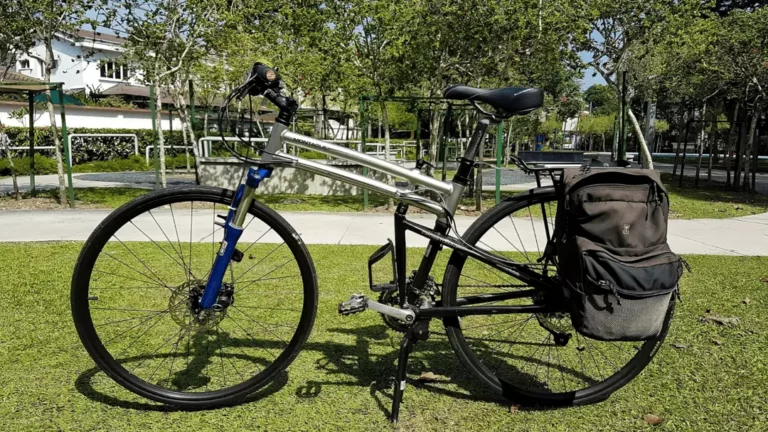Road Bicycle Weights: What Is A Good Bike Weight?

In order to go faster and with less air resistance, you want to consider the Road Bicycle Weights. The combined weight of you and your bike should be as low as possible. Given that the lightest materials tend to be the most expensive, you have to pay more money to ride sleeker bikes.
Road Bicycle Weights: An Overview
Most road bikes – that is, regular, everyday bicycles that range from averagely priced to slightly more expensive – weigh between 20 and 25 pounds, or 9 and 11 kilograms. They are usually made from inexpensive metals, like aluminum or steel.
Whereas, pricier bikes are crafted from high-tech, lightweight materials, like carbon fiber, which is far lighter – often getting as low as 10 pounds in weight for the entire bike! Of course, we’re talking about extravagant cycles here, so bear that in mind.
Try not to sweat it too much if your bike is a little on the heavy side. A couple of pounds extra isn’t going to drastically change your performance. Your own body weight matters a lot more than how heavy your bike is!
How do I weigh my bike?
Hold it while you weigh yourself! No, we’re serious – first, step onto the scales yourself and note down the number. Don’t be tempted to shave any pounds off, as there’s no point conducting a weigh if you’re not going to do so accurately!
Then, grab your bike (or take your scales to it) and step on again, this time whilst you hold it – try and stand as still as possible, and make sure your entire weight is being distributed evenly across the scale for an accurate measurement.
Takedown the second weight and subtract yours from it – that should tell you how much your bike weighs, or at least be a very good approximation! Given they’re not that heavy in general, you should be fine to use any normal household scale for this.
If you happen to have a handheld baggage scale – those little machines with hooks so you can weigh your suitcase before heading to the airport – you might be able to use that too, depending on how much weight it can detect.
How heavy are Tour de France bikes?
Any bike being used in a Union Cycliste Internationale (UCI) race, like the Tour de France, must weigh at least 6.8 kilograms.
Established back in 2000, this rule was intended to prevent injury to riders by ensuring that bike manufacturers did not try to decrease the weight of their cycles in a way that posed a risk to it being structurally sound.
In layman’s terms, the UCI didn’t want bikes to be made using shoddy equipment, and they also wanted to even the playing field and make sure all cyclists were competing on bikes of relatively similar weight.
Many competitors and amateur cyclists alike believe that this rule is outdated now, given that the introduction of materials like carbon fiber to the world of bike manufacture has revolutionized their ability to make lightweight cycles.
For instance, some of the bike frames on the world’s lightest bikes weigh less than 2 pounds altogether. That’s hardly anything at all! A toddler could lift it! But unfortunately, UCI did not predict this breakthrough in bicycle design technology.
Many participants in the Tour de France have been known to ride on bikes that are technically under the weight limit, adding weights to the frame so they hit 6.8kg. This is a decent protest of the rule, as the bikes clearly have structural integrity!
How much does a Trek bike weigh?
It depends on which one you’re talking about! This American brand is responsible for some of the lightest bikes on the market, from the Emonda and Domane to the Checkpoint and Madone, all of which are made from carbon.
Trek has developed its very own, patented material for crafting bikes, which they have dubbed OCLV, or Optimum Compaction, Low Void Carbon. It is their belief they have mastered the delicate balance of lightweight, durable, and stiff.
Their lightest bike, the Emonda SLR 9, has a frame weighing just 1.41 pounds, which is less than one kilogram! All in all, it weighs just 13.4 pounds altogether and was twice the choice of multiple Tour de France winner Alberto Contador.
As it weighs less than 6.8 kilograms (14.99 pounds) in total, it cannot be used for UCI competitions without the addition of weights to bring it up to code. Other bikes from their line tend to be 10 lbs or less in weight, with road bikes being a little heavier.
How much does weight affect climbing on a bicycle?
A rider’s weight certainly has some impact on their cycling performance. Even just a couple of pounds in difference is enough to boost your biking ability, particularly in situations where you’re working against even more gravity than usual, like climbing.
Whether there’s a sustained uphill climb or a short steep sudden incline, your weight will come into play, as the less there is of you to resist gravity’s forces, the easier it will be for you to push through to your destination.
Even though you might be able to reach the same speeds right now, it requires more power exertion from you to do so, so you’re pushing yourself harder to get to those speeds or conquer those hills.
Do be wary of how much weight you lose though – there’s only so much you can do before your body begins to dip below a healthy threshold, and some of us are just built heavier naturally! You could actually do yourself a detriment, cycling-wise.
What you make up for in lost body weight you will lose in power, as you’ll be too weak to really pedal as much as you could before. This is because once all body fat is gone, you’ll begin to wear away at your lean muscle, which is where your power comes from.
At the end of the day, a couple of pounds here or there isn’t going to make a huge difference, so don’t sweat it too much. That goes for you and your bike, to any weight weenies reading!

Steve Beck is a passionate cyclist and experienced writer covering the cycling industry for over a decade. He has a wealth of knowledge and expertise in all bike-related things, from the latest products and technologies to the best routes and trails. His articles are well-researched, informative, and engaging, and he has a talent for explaining complex cycling concepts in a way that is easy to understand. Steve can be found on the road when he’s not writing about bikes, putting his knowledge and skills to the test.








